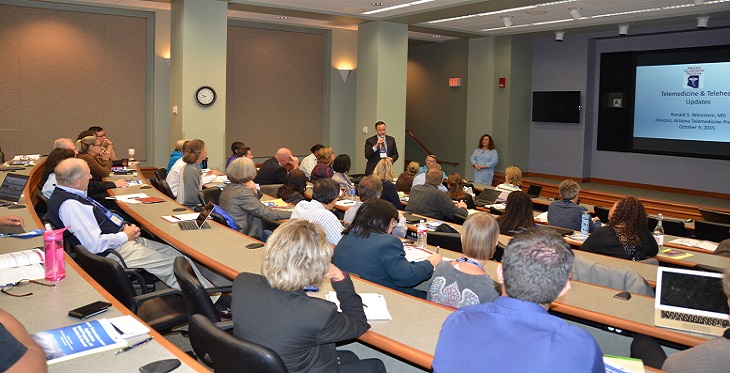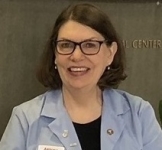Did you know that telestroke isn’t solely about determining whether a patient is having an ischemic stroke and needs a clot-busting drug? Or that telepsychiatrists feel that establishing a doctor-patient relationship via telemedicine (never meeting their patients in person) works well? Or that Arizona law requires informed consent before a patient can receive healthcare services through telemedicine?
These are just a few things participants learned at the daylong “Arizona Telemedicine Course: Applications, Model Programs, and Secrets for Success,” held October 9, 2015 at Flagstaff Medical Center.
The training program was offered by the Arizona Telemedicine Program (ATP) and its Southwest Telehealth Resource Center (SWTRC) and co-sponsored by three of northern Arizona’s most successful telemedicine programs:
- Health Choice Integrated Care (HCIC, formerly Northern Arizona Regional Behavioral Health Authority).
- North Country Healthcare (NCHC).
- Northern Arizona Healthcare (NAH), which hosted the event.
ATP/SWTRC telehealth training programs are accredited by the American Telemedicine Association. Though ATP/SWTRC training tracks are held regularly throughout the year at the ATP facilities in Tucson and Phoenix, this was only the second program in Flagstaff. Like the first Flagstaff training held in 2014, this also sold out and received rave reviews from participants.

“This was a great conference!” said one participant in the conference evaluation. “It was my first [telehealth training program] but very informative and motivating. Loved it!!”
“The topics were extremely timely,” said Fredda Kermes, Director for Professional Development, Telemedicine and Clinical Projects at Summit Healthcare in Show Low, Arizona. Citing the teleneurology presentation as one of the most eye-opening, she said, “It made me really think about what could we look at and apply in our own setting.”
All participants introduced themselves and their organization’s current telemedicine activities at the start of the day, which created an “excellent networking format,” according to attendee comments.
“Arizona has become a national epicenter for telemedicine and telehealth,” noted Ronald S. Weinstein, MD, Director of ATP. Dr. Weinstein is President Emeritus of the American Telemedicine Association.
“I really liked the way the introductions were done so you could understand why people were there and where they were working and what projects they were working on,” said Kermes. “I was able to connect with a couple of different people because of that. In fact, we were able to make a connection with one of the psychiatrists who was there when we learned that he actually comes and visits Lakeside and lives here part of the time.”
The program featured telemedicine leaders from around the state:
- Ronald S. Weinstein, MD, ATP Founding Director, emcee and moderator of a panel on recruiting telehealth physicians.
- Greg Hales, Telehealth Program Manager of NCHC, on chronic disease management through telemedicine.
- Sara Gibson, MD, Medical Director of Telemedicine for HCIC, on her 19-year experience with telepsychiatry.
- Jeff Lisse, MD, ATP Medical Director, on telerheumatology from a clinician’s point of view.
- Bart Demaerschalk, MD, Medical Director of the Mayo Clinic Telestroke and Teleneurology programs, on teleneurology, telestroke and tele-epilepsy programs.
- Robert Groves, Jr., MD, VP of Health Management at Banner Health and CMO of the Banner University Medical Division, on Banner’s successful eICU program.
- Gigi Sorenson, RN, MSN, Director of Telehealth for NAH, on building telehealth partnerships and starting a program.
- Nancy Rowe, ATP Associate Director for Outreach, on the business aspects of telemedicine.
- Michael Keeling, Esq., of Keeling Law Offices, on new Arizona policy and legislative initiatives.
- Janet Major, ATP Associate Director for Facilities, on choosing telehealth technology.
“This was awesome,” said one participant. “It is rare to attend a program where all the speakers were great.”
Over 90 percent of the course evaluations rated the overall training as “excellent.”
“The amount of knowledge gained and the networking and the information shared were extremely valuable and worth the time,” said Kermes. “I would recommend it for anyone.”
ATP/SWTRC trainings are $300, but the fee is waived for Arizona residents. Participants often return for additional trainings.
The ATP/SWTRC plans to bring a similar “on the road” training to Yuma, AZ, soon. Stay tuned to the ATP website for new training notices!

